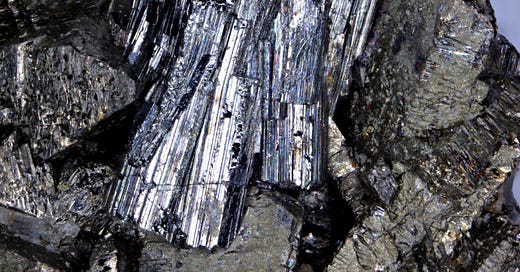Photographing shiny silvery black minerals can be a challenge. Reflections in particular are sometimes problematic. As can be getting the right contrast and exposure.
But get it right, and you end up with a good image. I am pretty happy with this nice group of bournonite crystals perched on brassy arsenopyrite and dark sphalerite crystals. You can also see a small chalcopyrite on the edge of one of the sphalerites.
Bournonite is relatively common in poly-metallic hydrothermal systems. It occurs as a steel or lead-grey metallic sulphosalt with a tabular to short striated crystal habit, often twinned (with classic examples as “cogwheels”), or as longer prismatic crystals. But really good bournonite crystals are not that common. There are of course, classic bournonite localities such as in Bolivia, China, Cornwall, France, Peru and Romania.
In Australia, the best specimens, even though they are small, are definitely from Tolwong in New South Wales.
The Tolwong Mine in New South Wales actually refers to a group of small mines, rather than a single large operation. They are located in the steep Shoalhaven Gorge area, roughly 10km south-south-east of Marulan, New South Wales. They were originally mined for gold in the mid-19th century, and in 1907, the Tolwong Mineral Company was formed to exploit deposits of arsenic, copper, and tin.
In addition to bournonite, Tolwong also produced nice crystals of other species including arsenopyrite, stannite, tetrahedrite, and even wurtzite.
Collecting is no longer allowed.
Below: Bournonite, sphalerite, arsenopyrite, Tolwong, St Vincent Co., New South Wales. Height of view 5mm. Click on the image for a higher resolution version.




